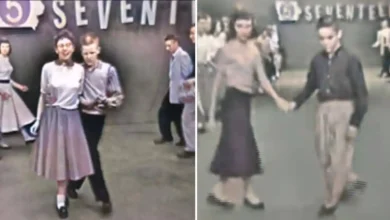Merle Haggard Delivered A Soulful Rendition Of “Mama Tried”
In the annals of country music, few songs resonate as deeply as Merle Haggard’s “Mama Tried.” Released in July 1968, this poignant ballad encapsulates the struggles of a wayward son and the enduring love of a mother who endeavored to guide him onto the right path. The song not only became a cornerstone of Haggard’s illustrious career but also left an indelible mark on the genre itself.
Merle Haggard’s journey to musical stardom was anything but conventional. Born in 1937 in Oildale, California, Haggard faced adversity from a young age. The death of his father when Merle was just nine years old had a profound impact on him. Left in the care of his hardworking mother, Flossie, young Merle often found himself in trouble, leading to a series of incarcerations during his youth.
These early life experiences heavily influenced Haggard’s songwriting. “Mama Tried” stands as a testament to this, reflecting the remorse of a son who recognizes the pain he caused his mother due to his rebellious actions. The lyrics, “I turned twenty-one in prison doing life without parole,” while not literally true for Haggard, capture the essence of his youthful transgressions and the resulting consequences.
The song’s authenticity is further amplified by Haggard’s personal history. In 1957, he was incarcerated in San Quentin State Prison for a botched robbery attempt. It was during this time that he witnessed a performance by Johnny Cash, an event that inspired him to turn his life around and pursue a career in music. This pivotal moment not only altered Haggard’s trajectory but also enriched his songwriting with genuine insights into the life of an outlaw.
Musically, “Mama Tried” is emblematic of the Bakersfield sound, a subgenre of country music that emerged as a reaction against the polished productions coming out of Nashville in the 1960s. Characterized by its raw edge, twangy guitars, and a honky-tonk vibe, the Bakersfield sound was pioneered by artists like Buck Owens and further popularized by Haggard. “Mama Tried” exemplifies this style, with its straightforward instrumentation and heartfelt delivery.
Upon its release, “Mama Tried” quickly climbed the charts, securing the number one spot on the Billboard Hot Country Singles chart in August 1968, where it remained for four consecutive weeks. This achievement marked Haggard’s fifth chart-topping single, solidifying his status as a leading figure in country music during that era.
The song’s impact extended beyond commercial success. It garnered critical acclaim and was later honored with a Grammy Hall of Fame Award in 1999. In 2016, recognizing its cultural, historical, and artistic significance, the Library of Congress selected “Mama Tried” for preservation in the National Recording Registry, ensuring its legacy for future generations.
Over the years, “Mama Tried” has been covered by numerous artists across various genres, underscoring its universal appeal. The Grateful Dead, known for their eclectic musical influences, incorporated the song into their live performances, playing it over 300 times throughout their career. This cross-genre appreciation highlights the song’s broad resonance and enduring relevance.
In popular culture, “Mama Tried” has made several notable appearances. It was featured in the 1968 film “Killers Three,” which also marked Haggard’s acting debut. More recently, the song was used in the 2008 horror film “The Strangers,” where its haunting melody added to the film’s eerie atmosphere. Such inclusions in media have introduced the song to new audiences, further cementing its place in the cultural zeitgeist.
Beyond its narrative of personal regret and maternal devotion, “Mama Tried” serves as a reflection of broader societal themes. It delves into the struggles of the working class, the challenges of single parenthood, and the complexities of redemption. These themes resonate with many, contributing to the song’s lasting impact and emotional depth.
Haggard’s ability to convey such profound emotions through his music is a testament to his songwriting prowess. His lyrics often drew from his own life experiences, lending an authenticity that resonated with listeners. This genuine connection to his material set Haggard apart and endeared him to fans worldwide.
The success of “Mama Tried” also played a significant role in shaping Haggard’s career trajectory. It reinforced his image as the voice of the common man, someone who understood and articulated the struggles and aspirations of everyday people. This persona became a defining aspect of his legacy, influencing countless artists who followed in his footsteps.
In the broader context of the music industry, “Mama Tried” exemplifies the power of storytelling in songwriting. Its narrative structure, combined with its emotive delivery, demonstrates how songs can transcend mere entertainment to become poignant reflections of the human experience. This approach has inspired numerous songwriters to infuse their work with personal stories and authentic emotions.
Decades after its release, “Mama Tried” continues to be celebrated as one of country music’s quintessential tracks. Its enduring popularity is a testament to its timeless themes and the sincerity of its delivery. As new generations discover Haggard’s music, the song’s legacy remains as potent as ever.
In conclusion, “Mama Tried” is more than just a song; it’s a narrative of redemption, a tribute to maternal love, and a reflection of personal growth. Through its heartfelt lyrics and authentic storytelling, Merle Haggard crafted a masterpiece that continues to resonate with audiences, solidifying its place in the pantheon of country music classics.



